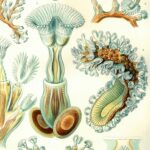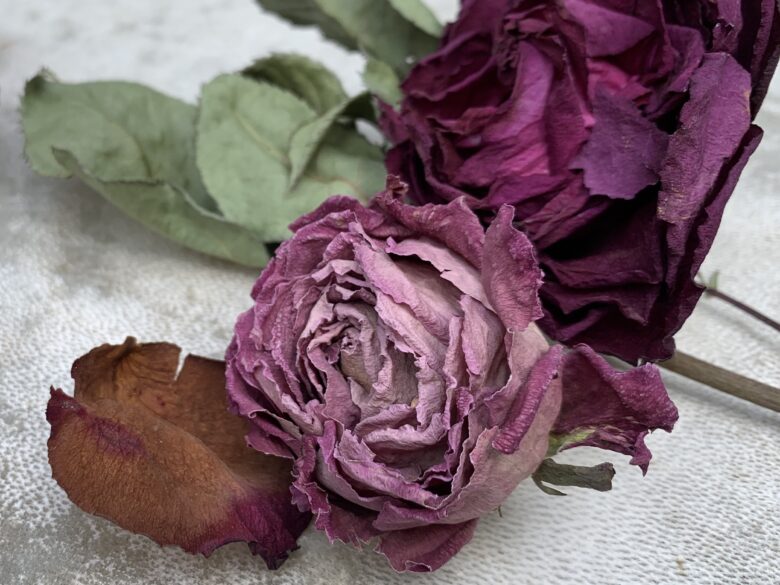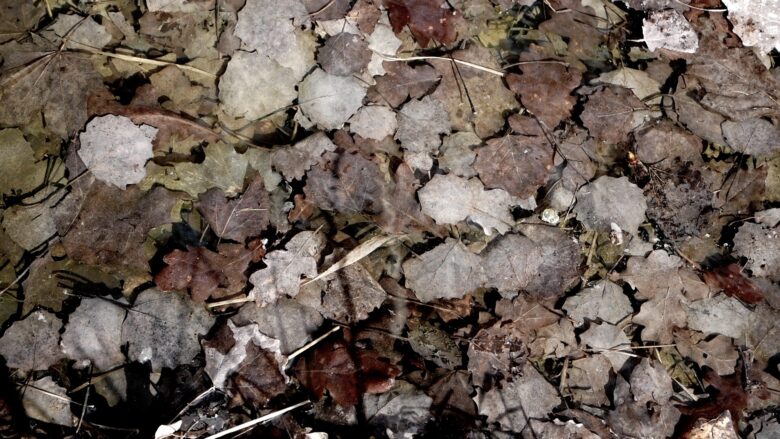A compositional ecology
with music, text, video and choreography by Pia Palme, June 2023
for violin, tenor trombone, three big drums (two horizontally mounted frame drums and a bass drum), nut chimes, bass recorders, spoken voice, with plant materials and paper
Duration up to 60 minutes
Composed for and inspired by the collaboration with Winnie Huang and Kevin T. Fairbairn
Premiered on 3 June 2023 at echoraum Vienna
The work was supported with a composition grant by the BMKOES Federal Ministry of Arts, Culture, Civil Service and Sport.

Why BRYOZOA?
Bryozoa, also known as moss animals, are ‘simple’ multicellular animals, aquatic invertebrates that expand from a party of one to a colony of thousands. They might encrust an entire kelp blade, or the underside of a ship’s hull. The individual bryozoan – a zooid – lives within a compartment made of calcium carbonate and chitin, a material found in crab shells. These calcium compartments can appear in ingenious forms and architectures. The animals live in salt water or fresh water environments and change between male and female stages during their lifetime.
For me, this mode of living, co-habitation and sharing looks very interesting. It is a complex form of culture and community, although it is formed by so-called ‘simple’ animals. Who says that they are simple, anyhow? I find this organic model of life inspiring for making music and for collaborating.
Like a colony of moss animals, my piece BRYOZOA consists of various modules or parts that can be assembled into a longer sequence, forming a kind of compositional colony. I wrote music and texts. There are notations for a sonic choreography of 2 and 4 hands moving on drums. I prepared improvised sections that are guided by spoken texts; these improvisations are performed with drums, plants or with the contrabass recorder and trombone. There is a longer, conventionally notated duo composition for violin and trombone; here, the trombonist is asked to perform a text during some passages.
The rose and the cedar cone
is a choreographic part for two performers who work with hands and plant material on two big frame drums. Recently, I found cones under a cedar tree and explored how the conifer’s seeds are arranged. They are closely folded in ingeniously compact layers, which easily come apart when the cone falls off and hits the ground. The layers remind me of rosebuds, their structure and arrangement are similar. So, I composed a choreography and text for two musicians who perform all kinds of movements and actions with roses and cedar cones, synchronized or in counterpoint. The soft noises emanating from the hands and plant material on the drum skins are amplified by two microphones placed underneath the table drums.


The photos show dried roses and a cedar cone on the drum skin, which were used as performance materials.
This piece celebrates the perception of touch
The piece contains a video of 12’30” duration which I made for this piece. I used material filmed during the Konen Saari Residence 2022. The video relates to the piece in several aspects: the perceptional qualities of skin and touch are themes that play an important part in the composition and video. The performers touch their fingers and hands to the skins of the drum membranes, plant materials are touched to the drum skins. The gentle – or not so gentle – movements of touch generate noises and sounds in this composition. These movements can be also be seen, there is a choreography of hand movements, finger movements, interactions and entanglements.
An erotic component
Touch and closeness are essential aspects of this music. The snakes featured in the video are very sensitive to touch. When they touch against each other, soft scraping noises become audible (these noises are not featured in the video, the video is silent). The performers’ movements against the drum skins reminded me of the snakes coiling against leaves and grass and against each other. Soft, wild, tender, energetic, touching, sounding, interacting. We interact with each other in so many ways, when we make music or in everyday life. The piece celebrates touch and close interaction. Touch has an erotic component: this is how we can interact with the world.
Here is a selection of video stills.




